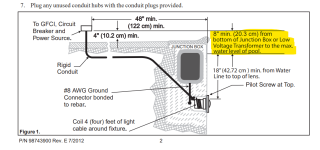Looks like the course of action here is to use the specialized box and check the requirements for distance from the pool, height above water level, and height above deck. The box location is uphill from the pool so it may be ok even through it is close to the ground.
I think
@JamesW and
@ajw22 offered some solid and thorough advice, and your planned course of action seems appropriate - although I don't recall seeing the word "uphill" in NEC 680

Not that you want to expand the project, but a few other things came to mind:
1. You might want to read more of NEC 680 to see about that other metallic conduit pictured in your photo, for it's height, use, distance from pool edge and therefore any additional requirements about bonding of it, where it goes, etc.
2. All controls / sources on tested GFCI circuits.
3. While working on the proper rated, elevated Jbox & related connections, you may want to check that #8 supplemental bonding wire coming from the spa niche for solid low-resistance connection to the rest of the bonding - such as measuring resistance back to the bonding wire on the equipment pad. Per the prior enclosed diagrams the niche would be bonded to the rest of the bonding grid - buried in the concrete - but good to verify same with an ohmmeter. Run that test with the other green ground wire disconnected at the Jbox so you're not reading "across a loop".
4. Given the old Jbox was not rated for pool use and mounted low to a fence, it makes me wonder about your other pool lighting.
5. I know 120V pool lighting remains a thing, and I love electricity, but I would consider installing a transformer at the pad and converting everything to 12V - and still driven by GFCI on the primary. It's just that the implications of things going wrong are so very deadly around 120volts and pools. I guess raising the Jbox may result in a cord length issue, so you may wind up replacing the luminaire with a longer integrated cord and a longer bonding wire from the niche.
Sorry if all that sounds like a lot






